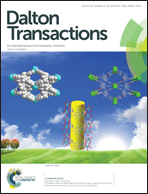Biologically active [Pd2L4]4+ quadruply-stranded helicates: stability and cytotoxicity†
Abstract
There is emerging interest in the anti-proliferative effects of metallosupramolecular systems due to the different size and shape of these metallo-architectures compared to traditional small molecule drugs. Palladium(II)-containing systems are the most abundant class of metallosupramolecular complexes, yet their biological activity has hardly been examined. Here a small series of [Pd2(L)4](BF4)4 quadruply-stranded, dipalladium(II) architectures were screened for their cytotoxic effects against three cancer cell lines and one non-malignant line. The helicates exhibited a range of cytotoxic properties, with the most cytotoxic complex [Pd2(hextrz)4](BF4)4 possessing low micromolar IC50 values against all of the cell lines tested, while the other helicates displayed moderate or no cytotoxicity. Against the MDA-MB-231 cell line, which is resistant to platinum-based drugs, [Pd2(hextrz)4](BF4)4 was 7-fold more active than cisplatin. Preliminary mechanistic studies indicate that the [Pd2(hextrz)4](BF4)4 helicate does not induce cell death in the same way as clinically used metal complexes such as cisplatin. Rather than interacting with DNA, the helicate appears to disrupt the cell membrane. These studies represent the first biological characterisation of quadruply-stranded helicate architectures, and provide insight into the design requirements for the development of biologically active and stable palladium(II)-containing metallosupramolecular architectures.
![Graphical abstract: Biologically active [Pd2L4]4+ quadruply-stranded helicates: stability and cytotoxicity](/en/Image/Get?imageInfo.ImageType=GA&imageInfo.ImageIdentifier.ManuscriptID=C5DT01259G&imageInfo.ImageIdentifier.Year=2015)

 Please wait while we load your content...
Please wait while we load your content...